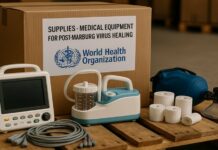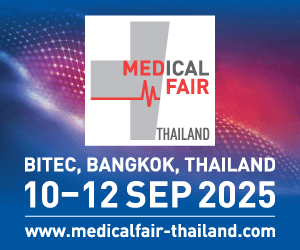Sunovion Pharmaceuticals Inc announced that the U.S. FDA issued a Complete Response Letter (CRL) for the New Drug Application (NDA) for SUN-101/eFlow® (glycopyrrolate) for the long-term, maintenance treatment of airflow obstruction in patients with chronic obstructive pulmonary disease (COPD),including chronic bronchitis and/or emphysema. The CRL does not require Sunovion to conduct any additional clinical studies for the approval of SUN-101/eFlow®.
Sunovion will work with the FDA to determine an appropriate path forward. We are confident in SUN-101/eFlow® and are committed to bringing this innovative therapy to COPD patients in the U.S. as quickly as possible.
About SUN-101/eFlow®
SUN-101 (glycopyrrolate) is a long-acting muscarinic antagonist (LAMA) bronchodilator delivered via the proprietary investigational eFlow® closed system nebulizer. SUN-101/eFlow® is currently in development as a nebulized treatment for patients with moderate-to-very-severe COPD. The investigational combined product, consisting of SUN-101 and the investigational eFlow® closed system nebulizer, which has been optimized for SUN-101 delivery, has not been approved by the FDA for the treatment of COPD.
About COPD
Chronic obstructive pulmonary disease (COPD) is a common, preventable and treatable disease that is characterized by persistent respiratory symptoms and airflow limitation that is due to airway and/or lung abnormalities usually caused by significant exposure to toxic particles or gases. The main risk factor for COPD is tobacco smoking, but other environmental exposures may contribute.1 Approximately 15.7 million adults in the U.S. report that they have been diagnosed with COPD.2 It is estimated that several million more adults have undiagnosed COPD.3 COPD is responsible for over 120,000 deaths per year, making it the third leading cause of death in the U.S.2 COPD develops slowly and the symptoms often worsen over time, potentially limiting the ability to perform routine activities.2 Symptoms of COPD include coughing, wheezing, shortness of breath, excess production of mucus in the lungs, the inability to breathe deeply and the feeling of being unable to breathe.4 The symptoms of COPD can be most severe during the night and early morning.5 Morning symptoms can be associated with limitation of activities during the day, impaired health status and increased risk of exacerbation.6 Night-time symptoms disturb sleep, reduce sleep quality and, in the long term, may be associated with development or worsening of cardiovascular diseases, cognition, depression and increased mortality.7
About Sunovion Pharmaceuticals Inc. (Sunovion)
Sunovion is a global biopharmaceutical company focused on the innovative application of science and medicine to help people with serious medical conditions. Sunovion’s vision is to lead the way to a healthier world. The company’s spirit of innovation is driven by the conviction that scientific excellence paired with meaningful advocacy and relevant education can improve lives. With patients at the center of everything it does, Sunovion has charted new paths to life-transforming treatments that reflect ongoing investments in research and development and an unwavering commitment to support people with psychiatric, neurological and respiratory conditions. Sunovion’s track record of discovery, development and commercialization of important therapies has included Utibron™ Neohaler® (indacaterol/glycopyrrolate) inhalation powder, Brovana® (arformoterol tartrate) inhalation solution, Latuda® (lurasidone HCI) and Aptiom® (eslicarbazepine acetate) Headquartered in Marlborough, Mass., Sunovion is an indirect, wholly-owned subsidiary of Sumitomo Dainippon Pharma Co., Ltd. Sunovion Pharmaceuticals Europe Ltd., based in London, England,Sunovion Pharmaceuticals Canada Inc., based in Mississauga, Ontario, and Sunovion CNS Development Canada ULC, based in Toronto, Ontario, are wholly-owned direct subsidiaries of Sunovion Pharmaceuticals Inc. Additional information can be found on the company’s web sites:
www.sunovion.com ,
www.sunovion.eu and
www.sunovion.ca .
About Sumitomo Dainippon Pharma Co., Ltd.
Sumitomo Dainippon Pharma is among the top-ten listed pharmaceutical companies in Japan operating globally in major pharmaceutical markets, including Japan, the United States, China and the European Union. Sumitomo Dainippon Pharma aims to create innovative pharmaceutical products in the Psychiatry & Neurology area and the Oncology area, which have been designated as the focus therapeutic areas. Sumitomo Dainippon Pharma is based on the merger in 2005 between Dainippon Pharmaceutical Co., Ltd., and Sumitomo Pharmaceuticals Co., Ltd. Today, Sumitomo Dainippon Pharma has about 6,500 employees worldwide. Additional information about Sumitomo Dainippon Pharma is available through its corporate website at
www.ds-pharma.com .
References
1 GOLD Guidelines 2017. http://www.goldcopd.org/guidelines-global-strategy-for-diagnosis-management.html. Accessed: March 16,2017.
2 MMWR: Morbidity and Mortality Weekly Report. Employment and Activity Limitations Among Adults with Chronic Obstructive
3 National Heart, Lung, and Blood Institute. “What is COPD?” Available at: http://www.nhlbi.nih.gov/health/educational/copd/what-iscopd/index.htm.
Accessed: March 2, 2016
5 Partridge MR, Karlsson N, Small IR. Patient insight into the impact of chronic obstructive pulmonary disease in the morning: an internet survey. Curr Med Res Opin. 2009;25:2043–8.
6 Roche N, Small M, Broomfield S, Higgins V, Pollard R. Real world COPD: association of morning symptoms with clinical and patient reported outcomes. COPD. 2013;10:679–86.
7 Agusti A, Hedner J, Marin JM, Barbé F, Cazzola M, Rennard S. Night-time symptoms: a forgotten dimension of COPD. Eur Respir Rev. 2011;20:183–94.

















